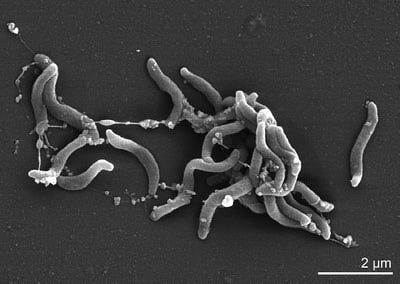Denitrovibrio acetiphilus
Classification
Domain: Bacteria;
Phylum: Deferribacteres
Class: Deferribacteres
Order: Deferribacterales
Family: Deferribacteraceae
Genus: Denitrovibrio(1)
Species
Species: acetiphilus (2)
|
NCBI: Taxonomy |
Denitrovibrio acetiphilus
Description and Significance
Describe the appearance, habitat, etc. of the organism, and why you think it is important.
Denitrovibrio acetiphilus is a marine, mesophilic, obligately anerobic organism. D. acetiphilus respires through nitrate reduction. [3]
Denitrovibrio acetiphilus is of phylogenetic interest because there are currently only six genera described in the family Deferribacteraceae. The organism was found in a laboratory column reducing nitrate to ammonia. The column simulated off-shore oil drilling conditions, and the presence of this organism will prove beneficial to stopping the process of undesired hydrogen sulfide formation. When nitrate is added to the system with sulfate reducing populations, production is overcome by these nitrate reducing bateria. [3]
Genome Structure
Describe the size and content of the genome. How many chromosomes? Circular or linear? Other interesting features? What is known about its sequence?
Denitrovibrio acetiphilus has two known completed genome sequences, of the order Deferribacterales and the class Deferribacteres. This is the sole class in the phylum Deferribacteres. The 3,222,077 bp genome is comprised of one main circular chromosome. There is 3,085 total genes of which 3,034 are protein-coding genes and 51 are RNA genes. This research is part of the G enomic E ncyclopedia of B acteria and A rchaea project (GEBA) [3]. A 16S rRNA gene analysis shows the strain of N2460T D. acetiphilus belongs to the Bacteria, with the closest relatives being ‘Geovibrio ferrieducens’, ‘Deferribacter thermophilus’, and ‘Flexistipes sinusarabici’ [2] (See Figure 2).
Cell Structure, Metabolism and Life Cycle
Interesting features of cell structure; how it gains energy; what important molecules it produces.
D. acetiphilus is a gram negative bacterium that possesses a curved rod shaped structure, similar to those in the genus, Vibrio. However, unlike those in the genus, D. acetiphilus are motile by bipolar flagellation and exhibit a rapid corkscrew movement. Cells of D. acetiphilus measure at 0.5-.07 by 1.7-2.0 µm and can be seen as singles, in pairs, or arranged in long chains. C16 and C18 fatty acids are major components of the cell membrane. [2]
Ecology and Pathogenesis
Habitat; symbiosis; biogeochemical significance; contributions to environment.
If relevant, how does this organism cause disease? Human, animal, plant hosts? Virulence factors, as well as patient symptoms.
As mentioned previously, this bacterium sheds insight into optimizing oil recovery in off-shore drilling. Presently, seawater is injected during oil recovery to increase efficiency. In most cases the seawater contains high concentrations of sulfate which in turn results in a higher population of sulfate-reducing bacteria at these mine sites. A common by-product of these sulfate-reducing bacteria is hydrogen sulfide (H2S) that is not only toxic and corrosive but can cause clogging and souring of the oil reservoir. Experiments have shown that adding nitrate to these reservoirs may reduce the production of hydrogen sulfide by stimulating the growth of nitrate-reducing bacteria that essentially over populating the sulfate-reducing bacteria. These results may provide a more economical solution to minimizing H2S by eliminated the need for expensive biocides [3].
References
[1] Denitrovibrio acetiphilus taxonomy - (http://www.catalogueoflife.org/details/species/id/4257206)
[2] Myhr, S., and Torsvik, T. "Denitrovibrio acetiphilus, a novel genus and species of dissimilatory nitrate-reducing bacterium isolated from an oil reservoir model column". International Journal of Systematic and Evolutionary Microbiology". 2000. Volume 50. pgs. 1611–1619 (http://ijs.sgmjournals.org/content/50/4/1611.full.pdf).
[3] Kiss, H., Lang, E., Lapidus, A., Copeland, A., Nolan, M., Glavina Del Rio, T., Chen, F., Lucas, S., Tice, H., Cheng, J., Han, C., Goodwin, L., Pitluck, S., Liolios, K., Pati, A., Ivanova, N., Mavromatis, K., Chen, A., Palaniappan, K., Land, M., Hauser, L., Chang, Y., Jeffries, C., Detter, J., Brettin, T., Spring, S., Rohde, M., GöKer, M., Woyke, T., Bristow, J., Eisen, J., Markowitz, V., Hugenholtz, P., Kyrpides, N., Klenk, H.. "Complete genome sequence of Denitrovibrio acetiphilus type strain (N2460T)". Standards in Genomic Sciences, North America, 2, jun. 2010. Available at: (http://www.standardsingenomics.org/index.php/sigen/article/view/sigs.892105) . Date accessed: 21 Mar. 2012.
Authors
Page authored by Rodney Tocco, Minh Tran, Samantha Wengert, and Eric Werner, students of Prof. Jay Lennon at Michigan State University.
<-- Do not remove this line-->


